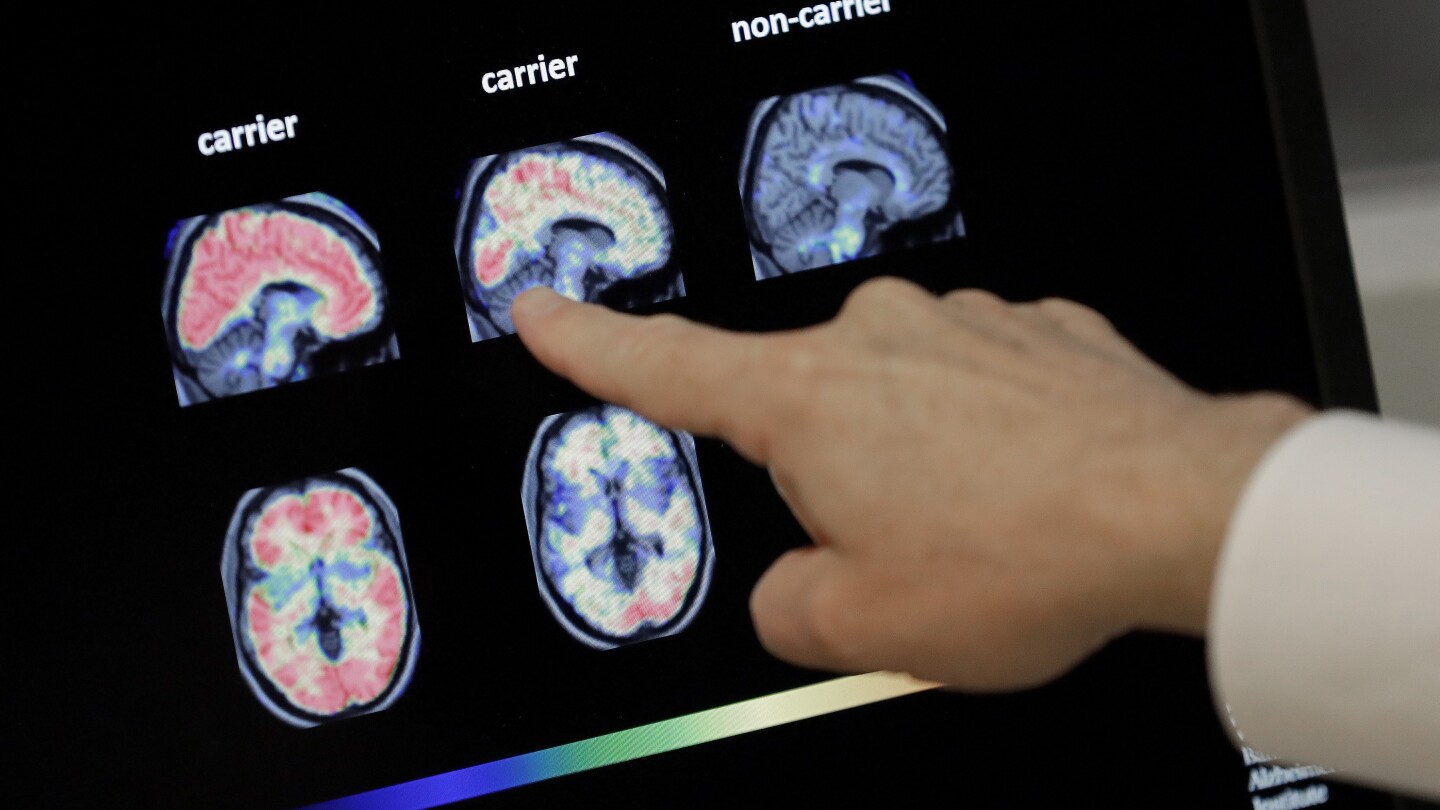Lifestyle
Shingles is awful, but there may be another reason to get vaccinated. It may fight dementia

WASHINGTON (AP) — A vaccine to fight dementia? It turns out there may already be one – shots that prevent painful shingles also appear to protect aging brains.
A new study found shingles vaccination cut older adults’ risk of developing dementia over the next seven years by 20%.
The research, published Wednesday in the journal Nature, is part of growing understanding about how many factors influence brain health as we age – and what we can do about it.
“It’s a very robust finding,” said lead researcher Dr. Pascal Geldsetzer of Stanford University. And “women seem to benefit more,” important as they’re at higher risk of dementia.
The study tracked people in Wales who were around 80 when receiving the world’s first-generation shingles vaccine over a decade ago. Now, Americans 50 and older are urged to get a newer vaccine that’s proven more effective against shingles than its predecessor.
The new findings add another reason for people to consider rolling up their sleeves, said Dr. Maria Nagel of the University of Colorado Anschutz Medical Campus, who studies viruses that infiltrate the nervous system.
The virus “is a risk for dementia and now we have an intervention that can decrease the risk,” Nagel said.
With Alzheimer’s and other forms of dementia on the rise in an aging population, “the implications of the study are profound,” Dr. Anupam Jena, a Harvard physician and health economist, wrote in a Nature commentary.
What is shingles?
Anyone who’s had ever had chickenpox – nearly everybody born before 1980 – harbors that virus for the rest of their life. It hides in nerves and can break out when the immune system weakens from illness or age, causing painful, blister-like sores typically on one side of the body that last for weeks – what’s called shingles.
About 1 in 3 Americans will get shingles, according to the Centers for Disease Control and Prevention. While most recover, it sometimes causes severe complications. If it infects an eye it can cause vision loss. Up to 20% of shingles patients suffer excruciating nerve pain months or even years after the rash itself is gone.
What’s the link between shingles and dementia?
It’s not clear exactly how Alzheimer’s and other types of dementia form. But certain viruses that sneak inside the nervous system – especially members of the herpes family including the chickenpox virus — have long been suspected of adding to genetic and other factors that make people more vulnerable.
Last summer, doctors at Boston’s Brigham and Women’s Hospital reported that an episode of shingles could raise someone’s risk of dementia by about 20%.
Partly, it’s because that virus can cause inflammation, bad for organs including the brain. It also can directly infect blood vessels in the brain, causing clots and impeding blood flow, said Colorado’s Nagel, a risk both for strokes and for dementia.
More intriguing, her lab also discovered shingles can spur formation of a sticky protein called amyloid that’s one of the hallmarks of Alzheimer’s.
Do shingles vaccines protect against dementia?
Adults who get recommended vaccines tend to have other brain-healthy habits including exercising and a good diet, which made it hard to prove an extra benefit.
Stanford’s Geldsetzer took advantage of “a natural experiment” in Wales, which opened shingles vaccinations with an age limit: anyone 80 or older on Sept. 1, 2013, was ineligible but those still 79 could squeeze in. Comparing seniors who just met or just missed that cutoff would mimic a research study that randomly assigned otherwise similar people to be vaccinated or not.
Geldsetzer’s team analyzed more than 280,000 medical records and found evidence that vaccination did offer some protection against dementia. At the time, people received a first-generation vaccine called Zostavax.
An important next step is testing whether today’s vaccine, Shingrix, also offers dementia protection, Nagel said. Another research group recently reported some evidence that it does. Vaccine manufacturer GSK last month announced a collaboration with UK health officials to track seniors’ cognitive health as they get vaccinated.
Geldsetzer also hopes to further study that earlier shot to see if the type of vaccine might make a difference.
What are the shingles vaccine recommendations?
Shingrix is a onetime vaccination, given in two doses a few months apart. The CDC recommends it starting at age 50 for most people but also for younger adults with certain immune-weakening conditions – including those who years ago got that first-generation shingles vaccine. Fewer than 40% of eligible Americans have gotten vaccinated.
Side effects including injection-site pain and flu-like fever and achiness are common. The CDC cautions if you’re currently fighting another virus such as the flu or COVID-19, to wait on a shingles shot until you’re well.
While there’s no proven prevention for dementia, doctors also recommend other commonsense steps to lower the risk. Stay socially and cognitively active. And control high blood pressure and, for people with diabetes, high blood sugar, both of which are linked to cognitive decline.
—-
The Associated Press Health and Science Department receives support from the Howard Hughes Medical Institute’s Science and Educational Media Group and the Robert Wood Johnson Foundation. The AP is solely responsible for all content.
Lifestyle
In Tunisia, snails inch toward replacing red meat as people turn to cheaper protein

AKOUDA, Tunisia (AP) — In fields outside their hometown in central Tunisia, an increasing number of unemployed young men are seeking a new way to make a living, picking snails off of rocks and leaves and collecting them in large plastic bags to take to the local market to be sold.
More and more people, they say, are buying the shelled wanderers as the price of market staples remains high and out of reach for many families.
“They’re profitable, beneficial and quite in demand,” said Karim, a 29-year-old snail seller from the village of Akouda said.
Snails have been consumed in Tunisia for more than seven millenia, according to research published last year in the journal Archaeological and Anthropological Sciences. In today’s world considered mostly a bistro delicacy, they’re again gaining traction in Tunisia as a practical alternative to red meat — a protein-rich substitute that pairs perfectly with salt, spices, and bold seasonings.
The snails are a lifeline for some in Tunisia, where youth unemployment now hovers above 40% and inflation remains high, three years after spiking to its highest levels in decades. A lack of opportunity has fueled social discontent throughout the country and, increasingly, migration to Europe.
Low in fat and high in iron, calcium and magnesium, snails offer both nutritional value and economic relief. In a country where unemployment runs high and median wages remain low, they cost about half as much as beef per kilogram and often less when sold by the bowl.
“Snails are better for cooking than lamb. If lamb meat costs 60 dinars ($19.30), a bowl of snails is five dinars ($1.60),” a man named Mohammed said at the Akouda market.
As the price of meat and poultry continues to rise, more Tunisians are turning to affordable, alternative sources of protein. Beyond their economic appeal, these substitutes are also drawing interest for their environmental benefits. Scientists say they offer a more sustainable solution, producing far fewer carbon emissions and avoiding the deforestation linked to traditional livestock farming.
Wahiba Dridi, who serves snails at her restaurant in Tunis, cooks them in a traditional fashion with peppers and spices. She said they were popular throughout this year’s Ramadan, which ended last week. Though Tunisian Muslims traditionally eat red meat at the meals during which they break their daily fasts, a kilogram of snails costs less than 28 Tunisian dinars ($9) compared to beef, which costs 55 dinars per kilogram ($18).
“If people knew the value of snails they would eat them all year long,” Dridi said.
Lifestyle
Living abroad and hungry to see a Chinese movie on the biggest of screens, some took action

COLUMBIA, Md. (AP) — A group of Chinese people decided they wanted the nation’s biggest movie to be big in the United States, literally. So they made it really big.
And therein lies a story.
On a recent Saturday afternoon, more than 100 people gathered at an IMAX screening room in a movie theater outside Baltimore. Many were Chinese students and young professionals nearby, parents took their kids, some of whom dressed as the movie’s main characters. Men and women wore Chinese traditional outfits. People lined up to sign their names onto a Chinese scroll and get tickets styled like traditional Chinese paintings. Some posed for pictures with red-tasseled spears and swords.
The screening was organized by volunteers among the Chinese community in the Baltimore-Washington, D.C., area. “Ne Zha 2,” the movie they came to see, is a Chinese film that replaced “Inside Out 2” as the highest-grossing animated film ever at around $2 billion.
You might never have heard of “Ne Zha 2,” though. It is not a big hit internationally. And that’s exactly what the people behind the screening want to change.
An ancient character gets a new treatment
In China, Ne Zha is a well-known traditional fairy character, a child god-general in heaven and also a naughty boy, who was introduced in a story called “Creation of the Gods” written about 400 years ago.
Sun Bohan, a 27-year-old student in Baltimore, wanted to watch the movie on IMAX. The problem? Every IMAX was playing “Captain America: Brave New World,” which premiered on the same day. He asked around and learned the only option would be to rent a theater and pay for the showing at the IMAX. But Sun couldn’t afford that on his own. So he posted on Xiaohongshu, a Chinese social media app; he also started a group on WeChat, China’s most popular messaging platform.
More than 100 people joined his effort and supported it in different capacities.
Raye Xia, a lover of manga, anime and games who had already watched the movie four times, saw Sun’s post and reached out. She spent hours painting a special ticket for the screening that depicted Ne Zha sitting on a dragon under the iconic Washington cherry blossom trees near the Jefferson Memorial.
“It is really rare to see such events in a small town. I love that I’m helping in my own way,” said Xia, who cosplayed as a movie character at the event.
Hoff Xu, a student in Baltimore, stayed up until 3 a.m. the night before and made her own outfit with copper wire, binder clips and old clothes.
“It is not an easy thing for everyone to get together, so I thought I would love to add some effect and vibe to this immersive experience,” Xu said.
Audience members love the cosplay outfits and lined up to take photos with those dressed up.
“As a Chinese, I am really proud to see a Chinese movie as the only one among the top 10 of something,” said Zhao Yuanyuan, who brought her son Jiang Wei’en, 7, to see the movie together for the second time, “I hope he can be exposed to and carry on Chinese traditional culture and not forget his own roots.”
A Chinese grassroots effort on American screens
The communal experience of seeing the movie — and, in particular, the community built by advocating its showing — can help Chinese people in the U.S. make in-person connections in the post-pandemic era. That’s particularly true for a movie some feel isn’t getting its rightful attention globally.
In the U.S., the gatherings reflect the anxiety among the Chinese community under the increasing institutionalized hostility toward immigrants, especially after President Donald Trump returned to office, says Belinda He, an assistant professor of Sinophone cinema and media studies at the University of Maryland.
“The emotional connection could purely outweigh the aesthetic impact and shock that the movie itself brings to them,” He said. “The more severe the institutionalized and structural exclusion here, the more people need to strive for some possibilities through real connections and a sense of belongings.”
Sun wasn’t the only one with the idea. Other Chinese living in the U.S. have organized theater rentals in Indianapolis, Boston and New York City.
Ma Ruoyuan, 31, who works in finance, worked with a friend to organize two screenings that drew a total of 600 people to watch the movie in New York. Ma says participants were highly involved in organizing the events, from seat booking to checking tickets. They even practiced democratic voting in the chat group so people could pick their preferences on the pricing system.
The movie’s rare access to an IMAX screen, Ma believes, is what “brought everyone together.”
IMAX Corp., headquartered in the Toronto area, said the high demand for IMAX screens means it requires studios booking months ahead, if not a year. The company said “Ne Zha 2” was shown on 80 screens for one day on Feb. 12 and expanded to 110 screens after “Captain America” ended.
“IMAX created opportunities to play ‘Ne Zha 2’ across its network in the United States, while honoring its earlier commitments to other releases,” the company said in a written statement.
Within China, “Ne Zha 2” is considered a patriotic movie. Media reports say internet celebrities, private companies and Chinese authorities organized special screenings for their followers and staff.
Earlier this month, all police officers from a court in the east coast province of Shandong were dispatched to watch the movie “to strengthen their belief in the rule of law and draw strength for progress,” the court said on its official Wechat account.
Sichuan, a province in China’s west, helped to fund the movie as part of a program using art projects to alleviate poverty. Media reports say the film’s producers received 15 million yuan ($2.1 million) from the Sichuan provincial government. CMC Pictures, the international production company that produced the movie, refused to comment.
For Sun, who stayed up the night before the screening in Maryland to bake cookies for the audience, the whole experience was an object lesson in collaboration among people who are making their way outside their own society.
“I started as just one person, but people with different skills all came to help,” he said after the screening. “It was worth it.”
Lifestyle
Brown University to see half a billion in federal funding halted by Trump administration

WASHINGTON (AP) — The Trump administration is planning to halt more than half a billion dollars in contracts and grants awarded to Brown University, adding to a list of Ivy League colleges that have had their federal money threatened as a result of their responses to antisemitism, a White House official said Thursday.
Nearly $510 million in federal contracts and grants are on the line, said the official, who was not authorized to speak publicly about the plan and spoke on condition of anonymity.
In an email Thursday to campus leaders, Brown Provost Frank Doyle said the university was aware of “troubling rumors” about government action on its research money. “At this moment, we have no information to substantiate any of these rumors,” Doyle said.
Brown would be the fifth Ivy League college targeted by President Donald Trump’s administration, which is using federal money to enforce its agenda at colleges. Dozens of universities — including every Ivy League school except Penn and Dartmouth — are facing federal investigations into antisemitism following a wave of pro-Palestinian protests last year.
Columbia University was the first one targeted, losing $400 million in federal money with threats to terminate more if it didn’t make the campus safer for Jewish students. The school agreed to several demands from the government last month, including an overhaul of student discipline rules and a review of the school’s Middle East studies department.
The government later suspended about $175 million in federal funding for the University of Pennsylvania over a transgender swimmer who previously competed for the school. On Monday, a federal antisemitism task force said it was reviewing almost $9 billion in federal grants and contracts at Harvard University amid an investigation into campus antisemitism.
And on Tuesday, Princeton University said the administration had halted dozens of its research grants.
The pressure has created a dilemma for U.S. colleges, which rely on federal research funding as a major source of revenue.
Trump’s administration has promised a more aggressive approach against campus antisemitism, accusing former President Joe Biden of letting schools off the hook. It has opened new investigations at colleges and detained and deported several foreign students with ties to pro-Palestinian protests. An incoming assistant professor of medicine at Brown was deported to Lebanon last month for having “openly admitted” to supporting a Hezbollah leader and attending his funeral, the Department of Homeland Security said.
During last school year’s campus protests against the Israel-Hamas war, Brown stood out for a deal it struck with student activists. In exchange for the students’ dismantling an encampment, the university committed to having its governing board vote on whether to divest from companies that protesters said were facilitating Israeli occupation of Palestinian territories.
The Corporation of Brown rejected the divestment proposal.
___
AP Education Writer Collin Binkley contributed. Mumphrey reported from Phoenix.
___
The Associated Press’ education coverage receives financial support from multiple private foundations. AP is solely responsible for all content. Find AP’s standards for working with philanthropies, a list of supporters and funded coverage areas at AP.org.
-

 Africa1 day ago
Africa1 day agoUS president announces global tariffs, including on 51 African nations
-

 Middle East2 days ago
Middle East2 days agoIsrael’s Netanyahu heads to Hungary in defiance of ICC arrest warrant | Gaza News
-

 Sports2 days ago
Sports2 days agoFreddie Freeman misses Los Angeles Dodgers game after injuring ankle in shower ‘mishap’
-

 Europe2 days ago
Europe2 days agoLive updates: Trump announces sweeping new tariffs on imports on ‘Liberation Day’
-

 Asia2 days ago
Asia2 days agoMyanmar’s military government announces temporary ceasefire to aid quake efforts
-

 Sports2 days ago
Sports2 days agoDaria Kasatkina: Russian-born tennis player ‘didn’t have much choice’ over switching allegiances to Australia
-

 Education2 days ago
Education2 days agoA trans teacher in Texas resigns after being targeted by conservatives online
-

 Education2 days ago
Education2 days agoNashville school shooter sought fame in 2023 attack that left 6 dead, report finds




